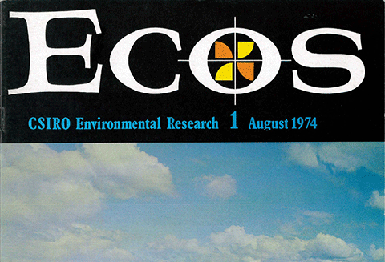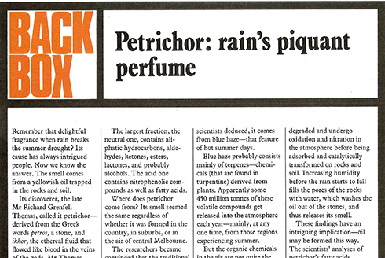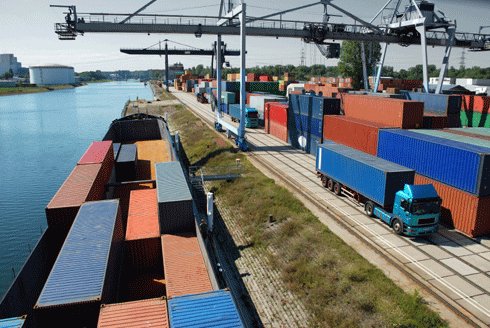
|
Published: 1 September 2014
ECOS@40: still deep, green, with a good dash of science
How do you take your science? In 140-character bites, or do you have an appetite for more? It turns out many ECOS readers prefer more than less when it comes to our online stories about sustainability-related science.
‘ECOS is one of the few remaining sources of trusted, accessible information on science and sustainability that covers the issues in a reasonable amount of depth,’ commented a reader in our online survey late last year.
‘There are plenty of sources of bite-sized, science journalism that skim the surface. ECOS meets a need for more in-depth consideration of issues.’
Another said: ‘I trust ECOS because over the years it has presented an informed and balanced view of science and sustainability. It is engaging and easy to read and doesn't overhype or sensationalise the topics it communicates.’
CSIRO published the first issue of ECOS in August 1974, when Australia’s population was just over 13 million (now it’s 23.5 million). The organisation’s Chairman at the time, James (Jerry) Price, wrote in the Foreword that the vision was to provide ‘ready access to existing scientific knowledge’ for those charged with managing the environment, by offering factual information (ie based on peer-reviewed science) ‘in a lucid and balanced way ‘ within a magazine format.
That first issue carried a story on CSIRO research to measure CO2 levels in the atmosphere (and remember, this is 1974!). The writer noted that CO2 levels at the time were 320 ppm (parts per million), up from 280 ppm in 1880 – today’s CO2 levels are hovering just below 400 ppm.
During the ‘80s, ‘90s and noughties, ECOS continued to follow up on the issue of climate change and greenhouse gas emissions. Here are some samples:
-
1976 – Researchers warned of rising CO2 levels in the atmosphere during the 20th century and the need for more data, including more on feedback effects (e.g. from the ‘albedo’ effect occurring when white polar ice is replaced by darker ocean).
-
1987 – We reported on the growing scientific consensus that a general global warming trend was happening: ‘It has become a matter of how to predict the regional details of these changes, rather than determining whether or not they will occur.’
-
1991 – ‘How high could the sea rise?’ discussed the uncertainties in predicting sea-level rise over coming decades.
-
1999 – ECOS published a ‘greenhouse effects’ special that included threats to coral reefs, agriculture and our unique tree-dwelling wildlife; as well as the prospect of our tropical cyclone belt migrating southward.
-
2009 – What happens if we overshoot the ‘safe’ atmospheric CO2 limit? We discussed the limited options available to rapidly withdraw carbon dioxide from the atmosphere through so-called ‘geoengineering’ solutions.
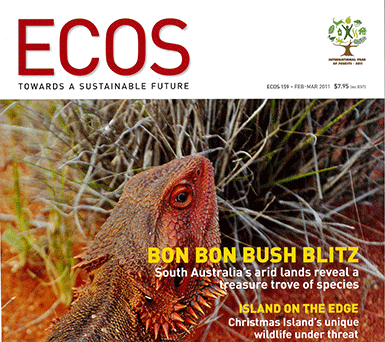
|
|
Biodiversity has been a recurring theme in ECOS: Feb-Mar 2011 issue featured stories on the natural riches of South Australia and Christmas Island. Credit:
CSIRO
|
Climate change is the tip of the iceberg, so to speak, when it comes to recurrent topics in ECOS. Since 1974, our writers and editors have interviewed many thousands of researchers and scanned hundreds of thousands of source documents to report on a huge diversity of topics. Here are some more examples:
-
In 1976, ‘Can we grow our fuel?’ explored how Australia might produce half its annual requirements of liquid fuels from vegetation by 2000, by producing ethanol from eucalypts, fuel from plant-waste pyrolysis (leaving biochar), and methane from anaerobic fermentation.
-
1983: Insights from acclaimed dingo researchers Laurie Corbett and Alan Newsome into the increasing rate of hybridisationbetween dingoes and feral dogs. They predicted that dingoes could eventually disappear as a result.
-
1984: CSIRO researchers detect a link between zinc deficiency and Aboriginal health, largely due to the change from traditional bush tucker to a western diet of processed food in remote communities.
-
1991: researchers begin a partnership with the Electricity Commission of NSW to identify suitable sites for wind farms. That research involved Dr Peter Coppin and led to two commercial spinoffs – Ecoult ‘wind smoothing’ technology and the WindScape™ wind mapping tool, the foundation of a successful global company, Windlab Systems Pty Ltd .
-
2009: ECOS even ventured into religion, exploring faith-based attitudes to environmental and social issues.
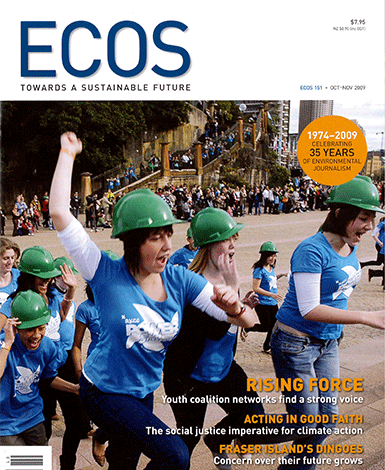
|
|
In ECOS 159, we explored the social justice imperative behind religious leaders speaking out on climate change, and the ‘rising force’ of young Australians taking action on the issue. Credit:
CSIRO
|
As you can see, ECOS has acted like a mirror over the decades, reflecting the preoccupations of science in the areas of the environment and sustainable development in Australia, often before those discussions became mainstream.
It’s an unrivalled one-stop archive of environmental writing and reporting in Australia – and the good news is that, since 2011, ECOS has been made available free, online for everyone to read.
So Happy Birthday ECOS, thank you all the committed editors, writers and production people over the years, and thank you especially to CSIRO for having the vision to get the conversation on the environment going and to keep it going.
Here’s to the next 40 years!
Mary-Lou Considine is the current Editor and acknowledges the significant contribution of previous Editors – Brian Woodruff, Bob Lehane, Bryony Bennett, Wendy Pyper, James Porteous and Michele Sabto – to ECOS. If you would like to sign up for the free ECOS monthly Contents Alert email, click here, insert your email address, and select ECOS from the displayed list of CSIRO Publishing publications. Feedback on ECOS is always welcome – please email the ECOS Editor.


